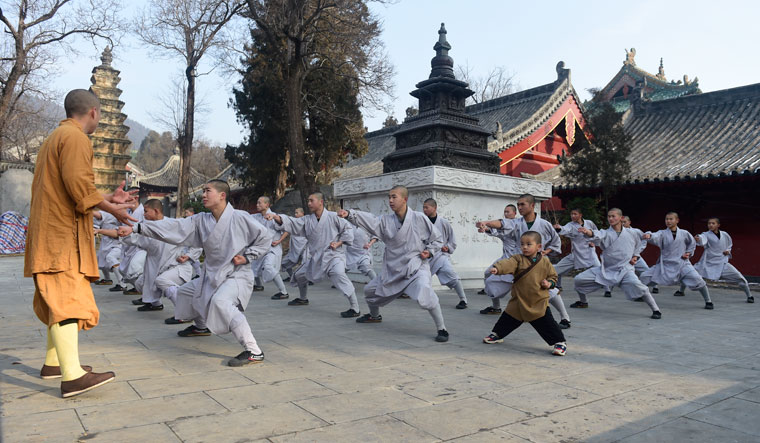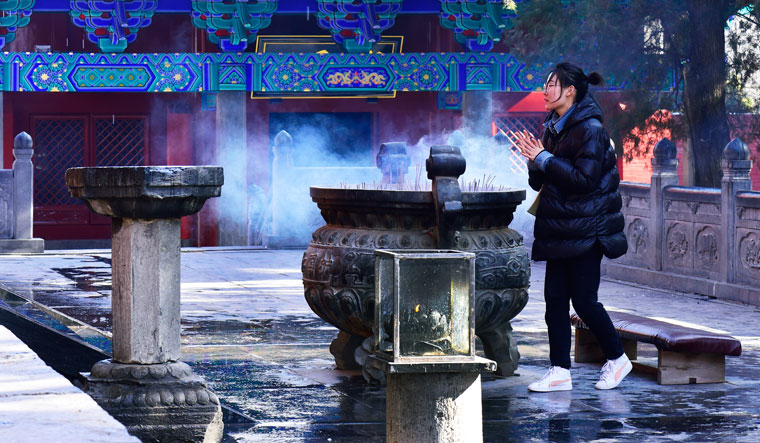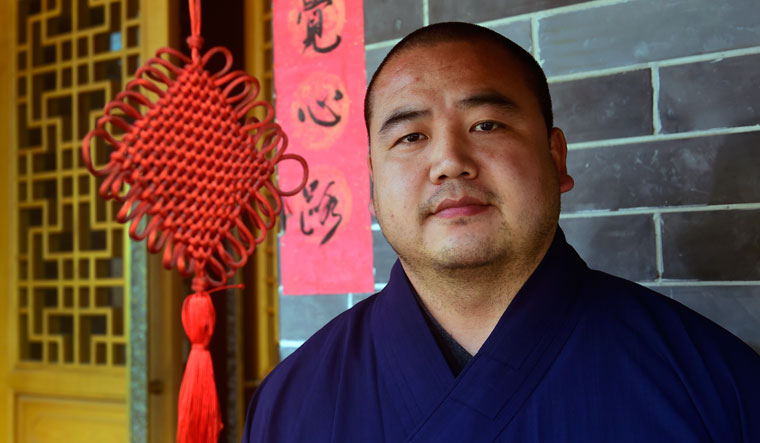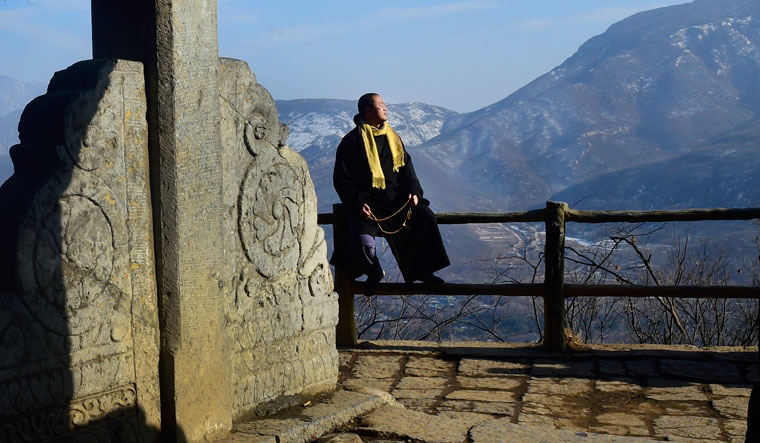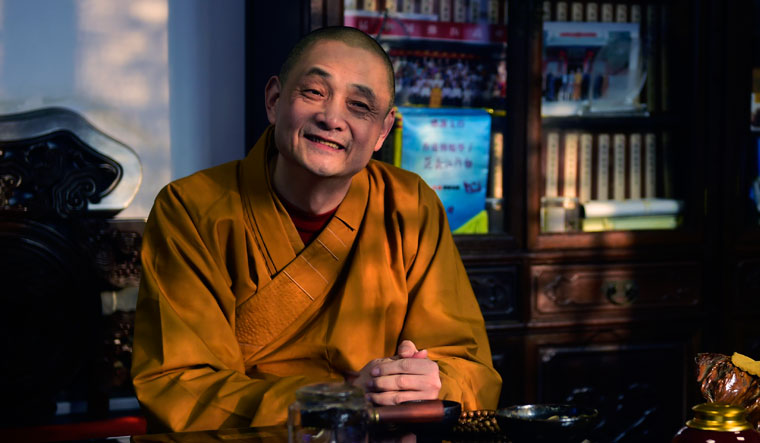It was a different world, a different India and a different China. When we set off to Zhengzhou, the capital city of Henan province in central China last January, the Covid-19 virus was yet to upend our lives. Although China had reported a few cases, life remained largely uneventful and there were hardly any travel restrictions. We landed in Zhengzhou on a freezing morning, with temperature dropping to minus five degrees Celsius.
We were on our way to the famous Shaolin temple, the original home of kung fu and Zen Buddhism. It was popularised by the legendary Bodhidharma, a Buddhist monk born to a Pallava king in south India. Bodhidharma, known as Damo in China and Daruma in Japan, is revered as the founder of the Zen school of Mahayana Buddhism.
Zhang Lifei, our guide and translator, was waiting for us at the airport lounge. “Call me Levy,” he said, steering the car out of the airport to the highway that leads to the Shaolin temple. “Everything about the temple revolves around Bodhidharma. Shao comes from the Shaoshi mountain and lin means forest. Hence, the name Shaolin,” said Levy.
Zhengzhou is one of eight ancient capitals of China, and the Shaolin temple is the economic centre of the entire province. The temple is 92km away from the city and on the way we saw many martial arts schools, run mostly by former monks of the Shaolin temple.
We had to get down near the main entrance of the temple complex and board a bus to the temple. The area around the temple had recently been taken over by the government to promote tourism. Local houseowners were sent away to nearby villages. As it was not the tourist season, there were only a few visitors. Levi said the locals were happy to see us as we were from India, the land of Bodhidharma.
Built in CE 495, the Shaolin temple came under attack many times. Some emperors respected the temple, some were indifferent, and a few were outrightly hostile. Some kings enlisted the warrior monks for their military campaigns. In CE 621, a group of Shaolin monks rescued a king of the Tang dynasty from an enemy warlord. In the 16th century, a group of monks led the fight against Japanese pirates.
The temple, a majestic structure, has seven main halls and courtyards. We stepped inside through the main gate called the Mountain Gate. To its left is the pharmacy section, and foreign students stay nearby. The kitchen, the storehouse and the dining hall are towards the right. We saw a huge tree with burned branches, a silent witness of the civil war that roiled China in the early 20th century. Many precious manuscripts, too, were torched. Next to the Mountain Hall is the Devar Hall, which was burnt down in 1928, but rebuilt in 1981. Adjoining the Devar Hall are the statues of the four heavenly guardians, looking after the four directions. Next is the Drum Hall, followed by the Mahaviro Hall, with an eye-catching idol of the Buddha. Right next to it is the fifth courtyard, the abode of Shi Yongxin, the current abbot.
The Bodhidharma Hall with an idol of Bodhidharma comes next, and, finally, at the end is the Thousand Buddha Hall, which has 48 footprints left by monks who used to practise in the hall. To its right is a closed room, where we saw what is said to be Bodhidharma’s shadow burned into the rocks from his years of meditation.
Wang Yumin, the international liaison officer of the temple, welcomed us with great enthusiasm. “You are our special guests, because you come from the land of Bodhidharma,” he said, smoking a cigarette. He said THE WEEK was the first Indian publication to officially visit the Shaolin temple. “Nearly three million tourists come here every year. We admit around 3,000 students a year to our kung fu classes. They pay $1,000 a month, which covers all expenses. We also offer scholarships,” he said. There is also a nunnery, but only five or six nuns were there and they lived outside the temple.
Also read
- Who is the Shaolin Temple’s ‘CEO monk’ under criminal investigation for embezzlement, misconduct in China?
- I had a blissful life transformation at the Shaolin temple
- Modi should visit the Shaolin temple
- The cure to my quarter life crisis
- India forgot Bodhidharma
- Shaolin kung fu is different from Kalaripayat
The temple is home to warrior monks who focus on physical training and scholar monks who are more into meditation and studies. The warrior monks stay near Wang’s office and the entry to the area is restricted. In a hall nearby, monks and students were practising kung fu. We met Shi Yandian, who was all set to teach kung fu to a group of local boys. All monks in the temple take the surname ‘Shi’. Yandian came to the temple 12 years ago and had served in the army. He was a warrior monk, who later passed an examination and became a scholar monk.
Yandian introduced us to three-year-old San Bao, who was attending a month-long course. “I know his parents and they stay close by. We take good care of the boy. But when he is training, we make sure he follows the rules,” said Yandian, as he instructed San to kneel down with his palm on the ground. As the father of a two-year-old, I felt uneasy seeing San strain like that. “In Shaolin kung fu you need to bear more to reach your limits. Emotions do not have a role here,” said Yandian. To my relief, he soon lifted San up and pampered him. “I am going to take him to my room for lunch,” he said.
The Shaolin temple was established in honour of Buddhabhadra, or Batuo, a monk from southern Nepal who preached Buddhism in China in the late fourth century. An emperor of the Wei dynasty built the temple, and appointed Buddhabhadra its first abbot. Bodhidharma came to the temple when Buddhabhadra was very old. But he failed to impress the abbot and was not allowed to enter the temple. He then sat facing a wall in a cave for nine years, in deep meditation. Legend has it that once he fell asleep during meditation. He was so angry with himself that he cut off his eyelids, which fell to the ground and turned into tea plants. So the monks have a stimulating enough reason for drinking tea to stay awake during meditation.
During Mao Zedong’s cultural revolution, the red army vandalised the temple and forced the monks to eat meat and drink alcohol. “The temple was burned and destroyed so many times, but its essence and teachings thrive even today. This is because Zen is passed from one person to the other,” said Shi Yanyong, a monk. Shi Yange, another monk who came to the temple in 2013, said he missed nothing, not even his parents. “I have started loving life even more after coming here,” he said.
Warrior monks sometimes travel abroad on shows. They perform in Shaolin cultural centres to promote kung fu. Two monks performed at the opening ceremony of the 2000 Sydney Olympics. Yanyong said Shaolin kung fu was different from other martial arts because of the influence of Zen Buddhism.
There are around 400 Shaolin cultural centres across the world, with the US alone having 80 centres. These centres train students in authentic kung fu and promote a healthy lifestyle through the teachings of Zen Buddhism.
Russian President Vladimir Putin, a martial arts expert himself, visited the temple in 2006. Chinese president Hu Jintao had been somewhat surprised when Putin, a judoka, expressed his desire to visit the temple. Putin then revealed that his two daughters practised kung fu with a Shaolin master and had visited the temple a few times.
In 2012, Medha Jaishankar, the daughter of External Affairs Minister S. Jaishankar, joined the Shaolin temple to cure what she describes as her quarter life crisis. Medha, who is a senior producer at a digital media and entertainment company, practised kung fu with a group of Russian students (see Medha’s article on page 54).
Indian leaders, however, have shown little interest in Shaolin. “Bodhidharma created kung fu. He brought to China what was then prevalent in India. Some forms of meditation practised here are close to yoga. And we have five Shaolin cultural centres in India,” said Shi Yanli, a monk. “The Indian government should identify the exact birthplace of Bodhidharma. We would like to build a Shaolin temple there. More people in India should know about Bodhidharma.”
Shi Yanlin, executive director of the temple and in charge of its medical wing, said the birthplace of Bodhidharma was near Chennai. “I have been there. I was taken to places like Mahabalipuram and Kanchipuram,” he said. He lamented that there was very little knowledge about Bodhidharma in India. “When I went to Chennai, I had with me a stone that looked like Damo (Bodhidharma) in a meditation pose. The customs officials at the airport asked me to pay tax for it. They had not heard about Bodhidharma and threatened to break the stone if I did not pay up,” he said. But he still enjoyed his stay in India and said he loved Indians. “Even while talking to you, I find so much happiness because you have come from the land of our Damo. More and more Indians should know about Bodhidharma and visit the Shaolin temple in China.”
Shi Yantia, the monk who manages the Cha’an (meditation) Hall, showed us some scholar monks meditating. Only those who know cross-legged kung fu can meditate in the hall. If someone dozes during meditation, an incense inspector will tap him on the shoulder with an incense board. “It is not that one has to meditate all the time. People are free to do other things at the temple. Meditation is mainly for the scholar monks,” said Yantia.
The monks at the temple usually eat rice, beans and sweet potatoes. The food is strictly vegetarian, except for warrior monks and foreign students who get eggs in a separate dining hall. Before they eat, the monks say a silent prayer and offer a small bowl of rice to birds outside.
All monks spend two hours in the morning practising kung fu. There is another two-hour session in the afternoon, which is optional for scholar monks, who can use the time to meditate. The warrior monks train mainly in traditional Shaolin warrior skills, and the scholar monks focus more on monastic study and practices. All monks have to participate in monastic rituals. A warrior monk can become a scholar monk by clearing an examination.
Outside the Cha’an Hall we met Marta Neškovic from Serbia. The 27-year-old was at the temple for her research in anthropology. “My PhD topic is the association between Shaolin kung fu and Zen Buddhism,” she said. Marta has been interested in Zen Buddhism since childhood. A scholarship helps her cover the $1,000 monthly fee.
Marta said once you joined the temple you should leave behind all extravagant needs of life. “I have to follow a certain discipline here. And I plan to be here for some time,” she said. Marta speaks Mandarin fluently. “We have to learn the language on our own. After a few months, all foreign students learn to speak Mandarin. It helps us communicate with trainers and monks.”
Max, a student from Ivory Coast, came to the temple two years ago. “I want to excel in kung fu. And there is no place better than Shaolin to learn it,” he said. He plans to stay in China for one more year.
A major attraction at the Shaolin temple is the pagoda forest, a huge park of nearly 250 brick pagodas built in memory of the abbots. Both the temple and the pagoda forest are UNESCO World Heritage Sites. “The pagoda forest is the final resting place of the higher monks. The oldest pagoda here is from the time of the Tang dynasty (CE 610-907),” said Shi Yan Luo, a monk.
Two kilometres northwest to the temple is the Bodhidharma cave in the Wuru Peak. The climb is steep, the path narrow. “But some monks run up to the cave and return in half an hour,” said Marta. Levy had advised us not to go there because the mountains were covered in snow. But we decided to give it a try.
The climb was not as exhausting as we had feared, but the cold wind and snow slowed our pace. We reached the cave in an hour. We saw devotees climbing up chanting mantras. Shi Yanyuan, the monk who accompanied us to the cave, said the visit to the Shaolin temple was not complete without a trek to the Bodhidharma cave.
Inside the cave, stood the Bodhidharma idol, flanked by two disciples, all in stone. It was here that Bodhidharma mediated facing the wall for nine long years. A few steps from the cave, on the summit of the Wuru Peak, there stood a 12m-high marble statue of Bodhidharma.
On the way down, we stopped at the Chuzhu temple, which had two idols placed next to each other. “These are Bodhidharma’s parents, but with a Chinese face,” said Yanyuan. We told him that the Tamil Nadu government was planning to build a massive statue of Bodhidharma in Kanchipuram. He said he yearned to visit Bodhidharma’s birthplace.
On our last day at the temple, two young Chinese women came to us, shouting “Indu (India)” in great excitement. Levy said they were confirming that we were indeed from the land of Bodhidharma and that they wanted to take a photograph with us. We happily obliged. As we were saying our goodbyes, one of the women took out a small picture of Bodhidharma from her handbag and kissed it. A gentle breeze blew, and I heard bells ringing in the temple. All hailing Lord Bodhidharma.



